2023 HYUNDAI SANTA CRUZ Automatic transmission operation
[x] Cancel search: Automatic transmission operationPage 179 of 598

05
5-43
Electrochromic Mirror with
Homelink System (if equipped)
Your vehicle may be equipped with
a Gentex Automatic-Dimming Mirror
with an Integrated HomeLink® Wireless
Control System.
During nighttime driving, this feature
will automatically detect and reduce
rearview mirror glare. The HomeLink®
Universal Transceiver allows you to
activate your garage door(s), electric
gate, home lighting, etc.
ODN8A059135ODN8A059135
(1) HomeLink Channel 1
(2) HomeLink Channel 2
(3) HomeLink Channel 3
(4) Garage Door Opener Status Indicator:
Closing or Closed
(5) HomeLink Operation Indicator
(6) Garage Door Opener Status Indicator:
Opening or Opened
(7) HomeLink User Interface Indicator
Integrated HomeLink® Wireless Control
System
The HomeLink® Wireless Control System
provides a convenient way to replace
up to three hand held radio-frequency
transmitters used to activate compatible
devices such as gate operators, garage
door openers, entry door locks, security
systems, and home lighting.
NOTICE
HomeLink® operates while the ignition
switch is in the ACC or ON position
for safety reasons. It is to prevent
unintentional security problems from
happening when the vehicle is parked
outside the garage.
WARNING
Before programming HomeLink® to a
garage door opener or gate operator,
make sure people and objects are out
of the way of the device to prevent
potential harm or damage. Do not
use the HomeLink® with any garage
door opener that lacks the safety
stop and reverse features required
by U.S. federal safety standards (this
includes any garage door opener model
manufactured before April 1, 1982).
A garage door that cannot detect an
object - signaling the door to stop and
reverse - does not meet current U.S.
federal safety standards. Using a garage
door opener without these features
increases the risk of serious injury or
death.
For more information, contact
HomeLink® at www.homelink.com, or
call Home-Link customer support at
1-800-355-3515.
It is also recommended that a new
battery be replaced in the handheld
transmitter of the device being trained
to HomeLink® for quicker training and
accurate transmission of the radio
frequency.
Page 275 of 598
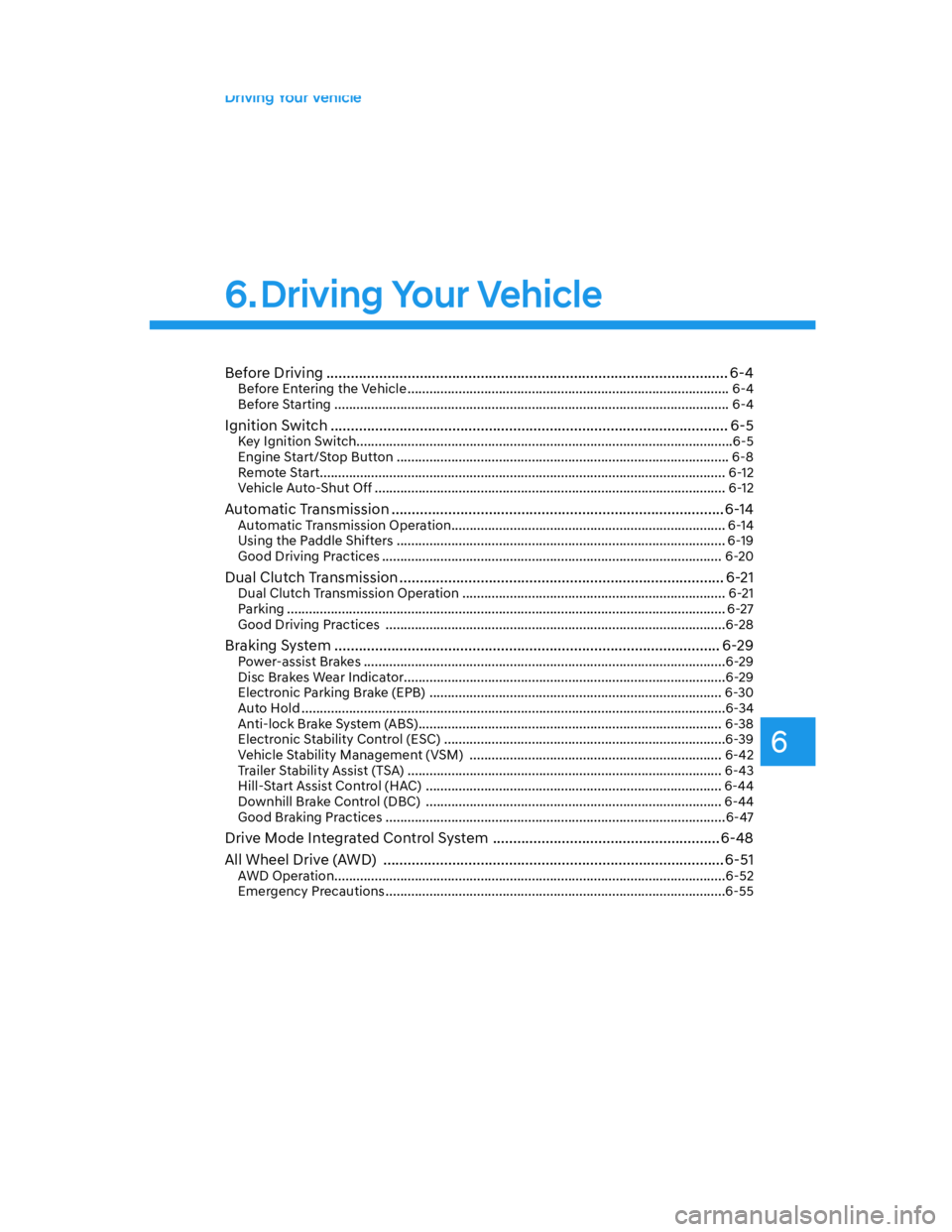
6
Before Driving ................................................................................................... 6-4Before Entering the Vehicle ........................................................................................ 6-4
Before Starting ............................................................................................................ 6-4
Ignition Switch .................................................................................................. 6-5
Key Ignition Switch .......................................................................................................6-5
Engine Start/Stop Button ........................................................................................... 6-8
Remote Start ............................................................................................................... 6-12
Vehicle Auto-Shut Off ................................................................................................ 6-12
Automatic Transmission ..................................................................................6-14
Automatic Transmission Operation ........................................................................... 6-14
Using the Paddle Shifters .......................................................................................... 6-19
Good Driving Practices ............................................................................................. 6-20
Dual Clutch Transmission ................................................................................ 6-21
Dual Clutch Transmission Operation ........................................................................ 6-21
Parking ........................................................................................................................6-27
Good Driving Practices .............................................................................................6-28
Braking System ............................................................................................... 6-29Power-assist Brakes ...................................................................................................6-29
Disc Brakes Wear Indicator........................................................................................6-29
Electronic Parking Brake (EPB) ................................................................................ 6-30
Auto Hold ....................................................................................................................6-34
Anti-lock Brake System (ABS) ................................................................................... 6-38
Electronic Stability Control (ESC) .............................................................................6-39
Vehicle Stability Management (VSM) ..................................................................... 6-42
Trailer Stability Assist (TSA) ...................................................................................... 6-43
Hill-Start Assist Control (HAC) ................................................................................. 6-44
Downhill Brake Control (DBC) ................................................................................. 6-44
Good Braking Practices .............................................................................................6-47
Drive Mode Integrated Control System ........................................................6-48
All Wheel Drive (AWD) ....................................................................................6-51
AWD Operation ...........................................................................................................6-52
Emergency Precautions .............................................................................................6-55
6. Driving Your Vehicle
Driving Your Vehicle
Page 288 of 598
![HYUNDAI SANTA CRUZ 2023 Owners Manual Driving Your Vehicle
6-14
ONX4E060039ONX4E060039
[A] : Shift lever, [B] : Shift release button, [C] : Manual shift mode
Depress the brake pedal and press the Shift release button while moving the shif HYUNDAI SANTA CRUZ 2023 Owners Manual Driving Your Vehicle
6-14
ONX4E060039ONX4E060039
[A] : Shift lever, [B] : Shift release button, [C] : Manual shift mode
Depress the brake pedal and press the Shift release button while moving the shif](/manual-img/35/56179/w960_56179-287.png)
Driving Your Vehicle
6-14
ONX4E060039ONX4E060039
[A] : Shift lever, [B] : Shift release button, [C] : Manual shift mode
Depress the brake pedal and press the Shift release button while moving the shift lever.
Press the Shift release button while moving the shift lever.
The shift lever can freely operate.
Automatic Transmission Operation
The automatic transmission has eight forward speeds and one reverse speed.
The individual speeds are selected automatically in the D (Drive) position.
AUTOMATIC TRANSMISSION
Page 300 of 598
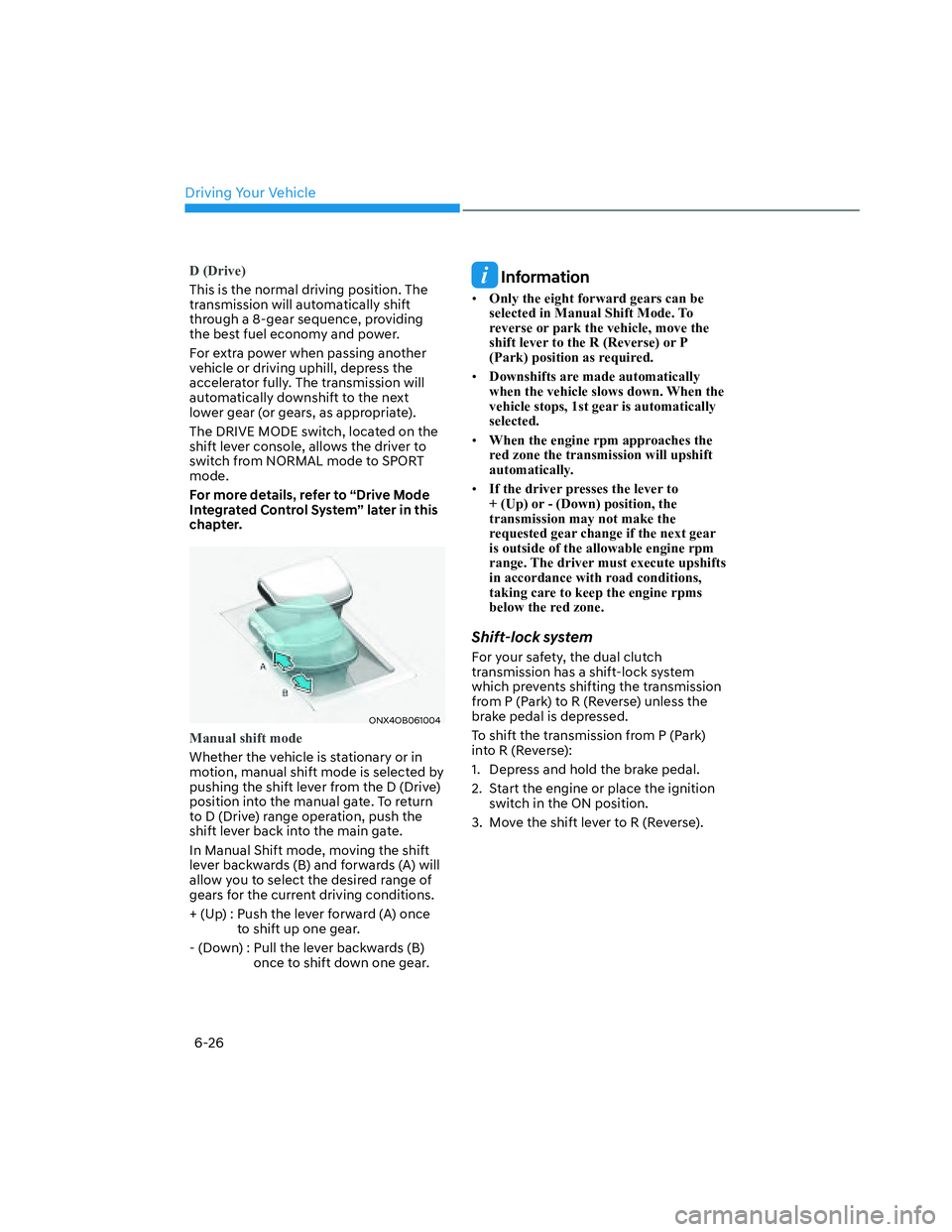
Driving Your Vehicle
6-26
D (Drive)
This is the normal driving position. The
transmission will automatically shift
through a 8-gear sequence, providing
the best fuel economy and power.
For extra power when passing another
vehicle or driving uphill, depress the
accelerator fully. The transmission will
automatically downshift to the next
lower gear (or gears, as appropriate).
The DRIVE MODE switch, located on the
shift lever console, allows the driver to
switch from NORMAL mode to SPORT
mode.
For more details, refer to “Drive Mode
Integrated Control System” later in this
chapter.
ONX4OB061004ONX4OB061004
Manual shift mode
Whether the vehicle is stationary or in
motion, manual shift mode is selected by
pushing the shift lever from the D (Drive)
position into the manual gate. To return
to D (Drive) range operation, push the
shift lever back into the main gate.
In Manual Shift mode, moving the shift
lever backwards (B) and forwards (A) will
allow you to select the desired range of
gears for the current driving conditions.
+ (Up) : Push the lever forward (A) once
to shift up one gear.
- (Down) : Pull the lever backwards (B)
once to shift down one gear.
Information
• Only the eight forward gears can be
selected in Manual Shift Mode. To
reverse or park the vehicle, move the
shift lever to the R (Reverse) or P
(Park) position as required.
• Downshifts are made automatically
when the vehicle slows down. When the
vehicle stops, 1st gear is automatically
selected.
• When the engine rpm approaches the
red zone the transmission will upshift
automatically.
• If the driver presses the lever to
+ (Up) or - (Down) position, the
transmission may not make the
requested gear change if the next gear
is outside of the allowable engine rpm
range. The driver must execute upshifts
in accordance with road conditions,
taking care to keep the engine rpms
below the red zone.
Shift-lock system
For your safety, the dual clutch
transmission has a shift-lock system
which prevents shifting the transmission
from P (Park) to R (Reverse) unless the
brake pedal is depressed.
To shift the transmission from P (Park)
into R (Reverse):
1. Depress and hold the brake pedal.
2. Start the engine or place the ignition
switch in the ON position.
3. Move the shift lever to R (Reverse).
Page 324 of 598
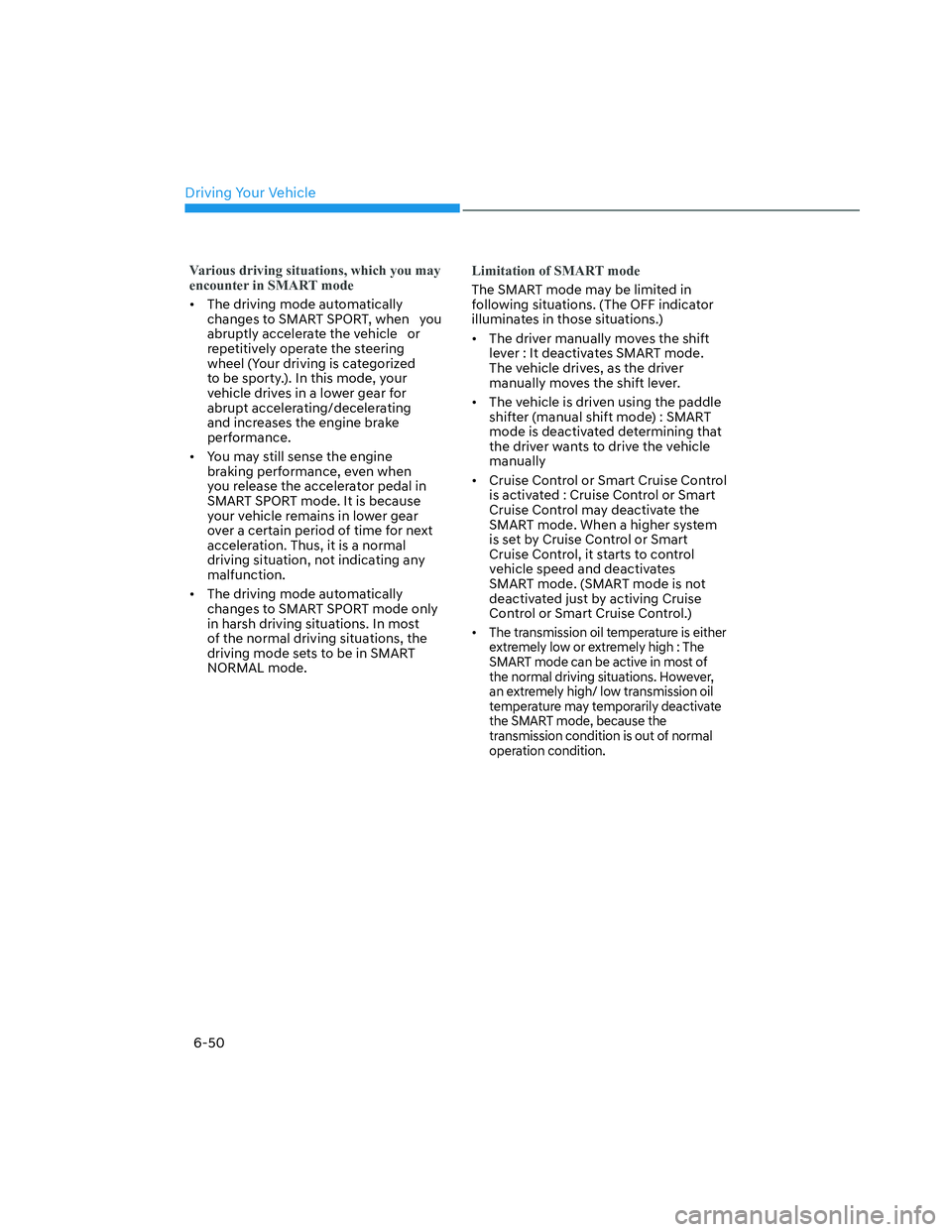
Driving Your Vehicle
6-50
Various driving situations, which you may
encounter in SMART mode
• The driving mode automatically
changes to SMART SPORT, when you
abruptly accelerate the vehicle or
repetitively operate the steering
wheel (Your driving is categorized
to be sporty.). In this mode, your
vehicle drives in a lower gear for
abrupt accelerating/decelerating
and increases the engine brake
performance.
• You may still sense the engine
braking performance, even when
you release the accelerator pedal in
SMART SPORT mode. It is because
your vehicle remains in lower gear
over a certain period of time for next
acceleration. Thus, it is a normal
driving situation, not indicating any
malfunction.
• The driving mode automatically
changes to SMART SPORT mode only
in harsh driving situations. In most
of the normal driving situations, the
driving mode sets to be in SMART
NORMAL mode.
Limitation of SMART mode
The SMART mode may be limited in
following situations. (The OFF indicator
illuminates in those situations.)
• The driver manually moves the shift
lever : It deactivates SMART mode.
The vehicle drives, as the driver
manually moves the shift lever.
• The vehicle is driven using the paddle
shifter (manual shift mode) : SMART
mode is deactivated determining that
the driver wants to drive the vehicle
manually
• Cruise Control or Smart Cruise Control
is activated : Cruise Control or Smart
Cruise Control may deactivate the
SMART mode. When a higher system
is set by Cruise Control or Smart
Cruise Control, it starts to control
vehicle speed and deactivates
SMART mode. (SMART mode is not
deactivated just by activing Cruise
Control or Smart Cruise Control.)
• The transmission oil temperature is either
extremely low or extremely high : The
SMART mode can be active in most of
the normal driving situations. However,
an extremely high/ low transmission oil
temperature may temporarily deactivate
the SMART mode, because the
transmission condition is out of normal
operation condition.
Page 514 of 598
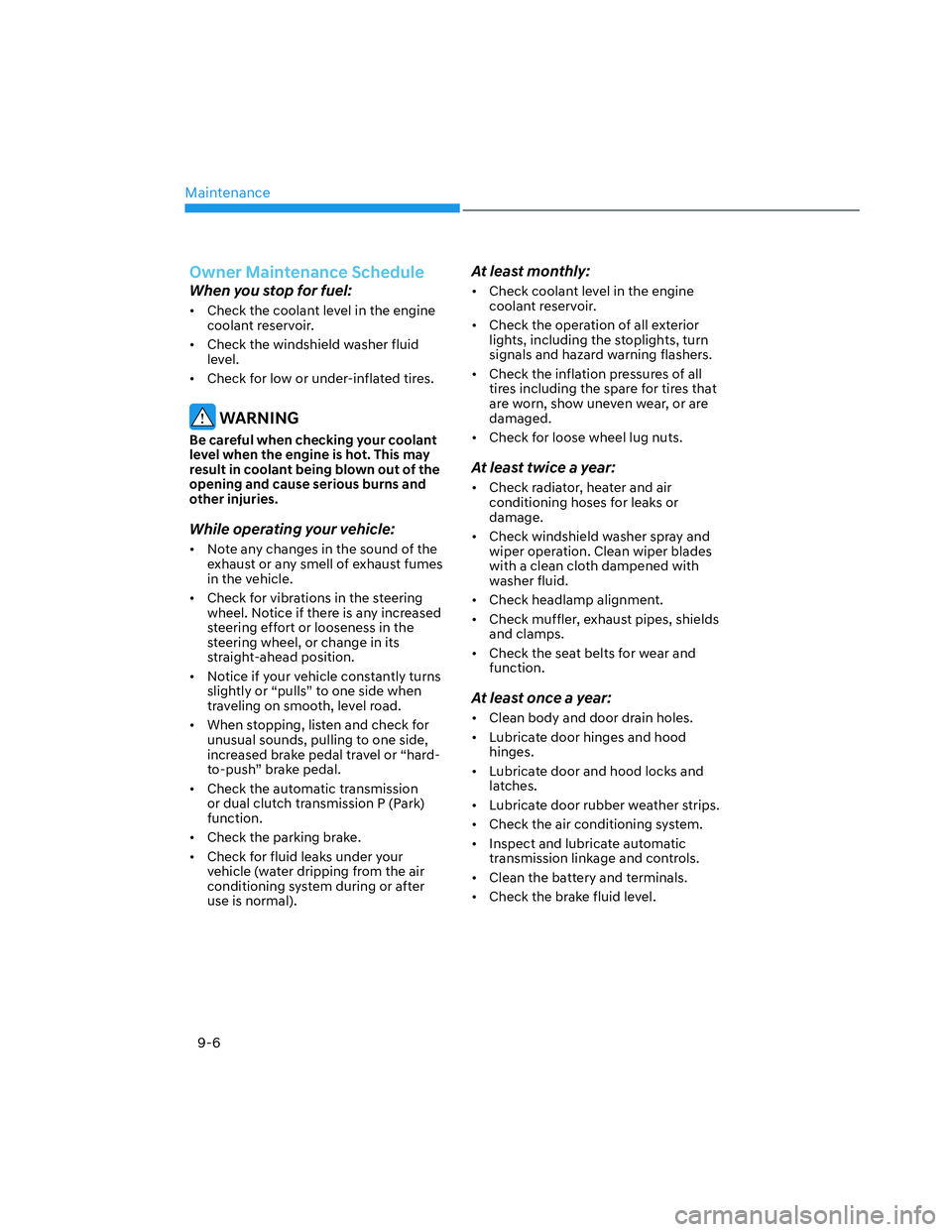
Maintenance
9-6
Owner Maintenance Schedule
When you stop for fuel:
• Check the coolant level in the engine
coolant reservoir.
• Check the windshield washer fluid
level.
• Check for low or under-inflated tires.
WARNING
Be careful when checking your coolant
level when the engine is hot. This may
result in coolant being blown out of the
opening and cause serious burns and
other injuries.
While operating your vehicle:
• Note any changes in the sound of the
exhaust or any smell of exhaust fumes
in the vehicle.
• Check for vibrations in the steering
wheel. Notice if there is any increased
steering effort or looseness in the
steering wheel, or change in its
straight-ahead position.
• Notice if your vehicle constantly turns
slightly or “pulls” to one side when
traveling on smooth, level road.
• When stopping, listen and check for
unusual sounds, pulling to one side,
increased brake pedal travel or “hard-
to-push” brake pedal.
• Check the automatic transmission
or dual clutch transmission P (Park)
function.
• Check the parking brake.
• Check for fluid leaks under your
vehicle (water dripping from the air
conditioning system during or after
use is normal).
At least monthly:
• Check coolant level in the engine
coolant reservoir.
• Check the operation of all exterior
lights, including the stoplights, turn
signals and hazard warning flashers.
• Check the inflation pressures of all
tires including the spare for tires that
are worn, show uneven wear, or are
damaged.
• Check for loose wheel lug nuts.
At least twice a year:
• Check radiator, heater and air
conditioning hoses for leaks or
damage.
• Check windshield washer spray and
wiper operation. Clean wiper blades
with a clean cloth dampened with
washer fluid.
• Check headlamp alignment.
• Check muffler, exhaust pipes, shields
and clamps.
• Check the seat belts for wear and
function.
At least once a year:
• Clean body and door drain holes.
• Lubricate door hinges and hood
hinges.
• Lubricate door and hood locks and
latches.
• Lubricate door rubber weather strips.
• Check the air conditioning system.
• Inspect and lubricate automatic
transmission linkage and controls.
• Clean the battery and terminals.
• Check the brake fluid level.
Page 521 of 598
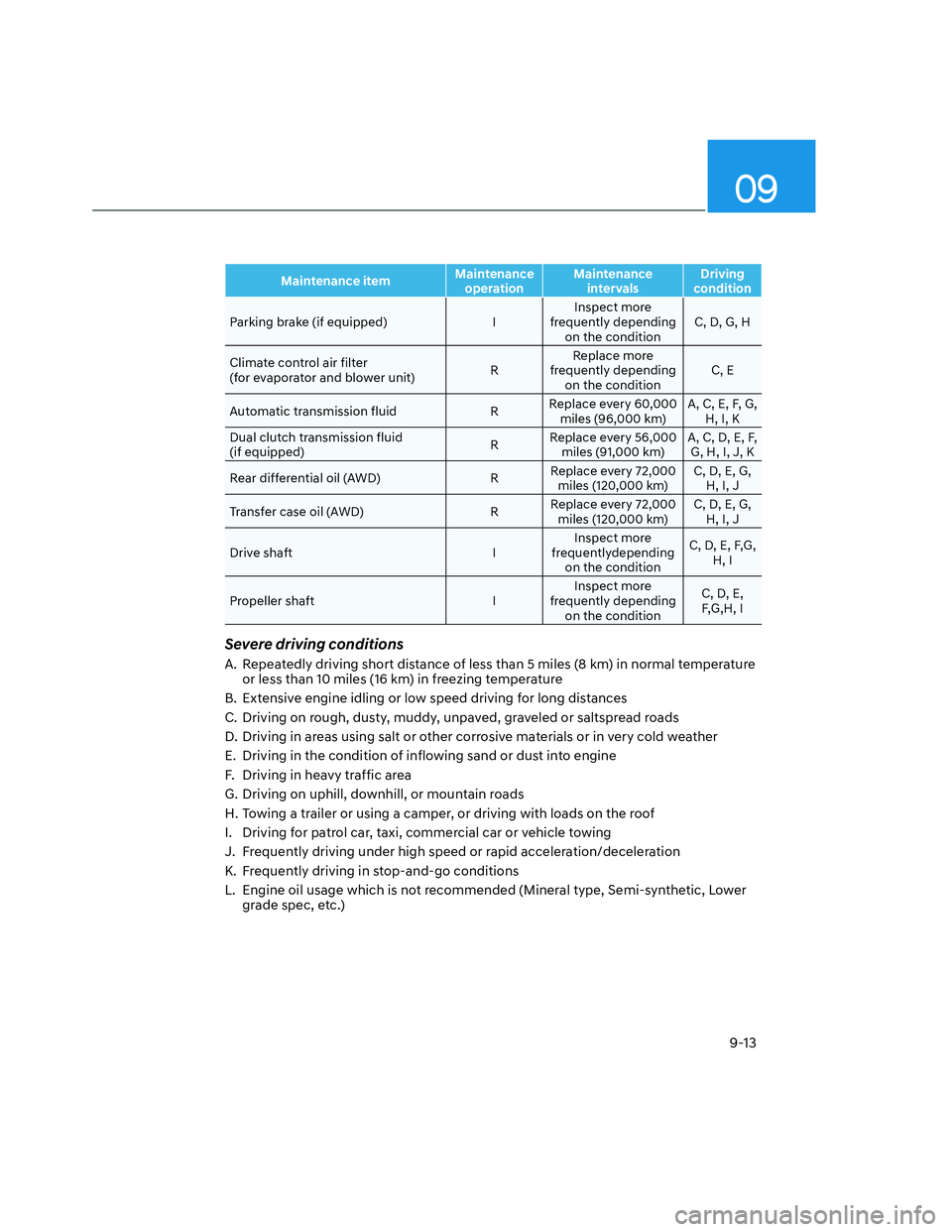
09
9-13
Maintenance itemMaintenance
operationMaintenance
intervalsDriving
condition
Parking brake (if equipped) IInspect more
frequently depending
on the conditionC, D, G, H
Climate control air filter
(for evaporator and blower unit)RReplace more
frequently depending
on the conditionC, E
Automatic transmission fluid RReplace every 60,000
miles (96,000 km)A, C, E, F, G,
H, I, K
Dual clutch transmission fluid
(if equipped)RReplace every 56,000
miles (91,000 km)A, C, D, E, F,
G, H, I, J, K
Rear differential oil (AWD) RReplace every 72,000
miles (120,000 km)C, D, E, G,
H, I, J
Transfer case oil (AWD) RReplace every 72,000
miles (120,000 km)C, D, E, G,
H, I, J
Drive shaft IInspect more
frequentlydepending
on the conditionC, D, E, F,G,
H, I
Propeller shaft IInspect more
frequently depending
on the conditionC, D, E,
F,G,H, I
Severe driving conditions
A. Repeatedly driving short distance of less than 5 miles (8 km) in normal temperature
or less than 10 miles (16 km) in freezing temperature
B. Extensive engine idling or low speed driving for long distances
C. Driving on rough, dusty, muddy, unpaved, graveled or saltspread roads
D. Driving in areas using salt or other corrosive materials or in very cold weather
E. Driving in the condition of inflowing sand or dust into engine
F. Driving in heavy traffic area
G. Driving on uphill, downhill, or mountain roads
H. Towing a trailer or using a camper, or driving with loads on the roof
I. Driving for patrol car, taxi, commercial car or vehicle towing
J. Frequently driving under high speed or rapid acceleration/deceleration
K. Frequently driving in stop-and-go conditions
L. Engine oil usage which is not recommended (Mineral type, Semi-synthetic, Lower
grade spec, etc.)
Page 586 of 598
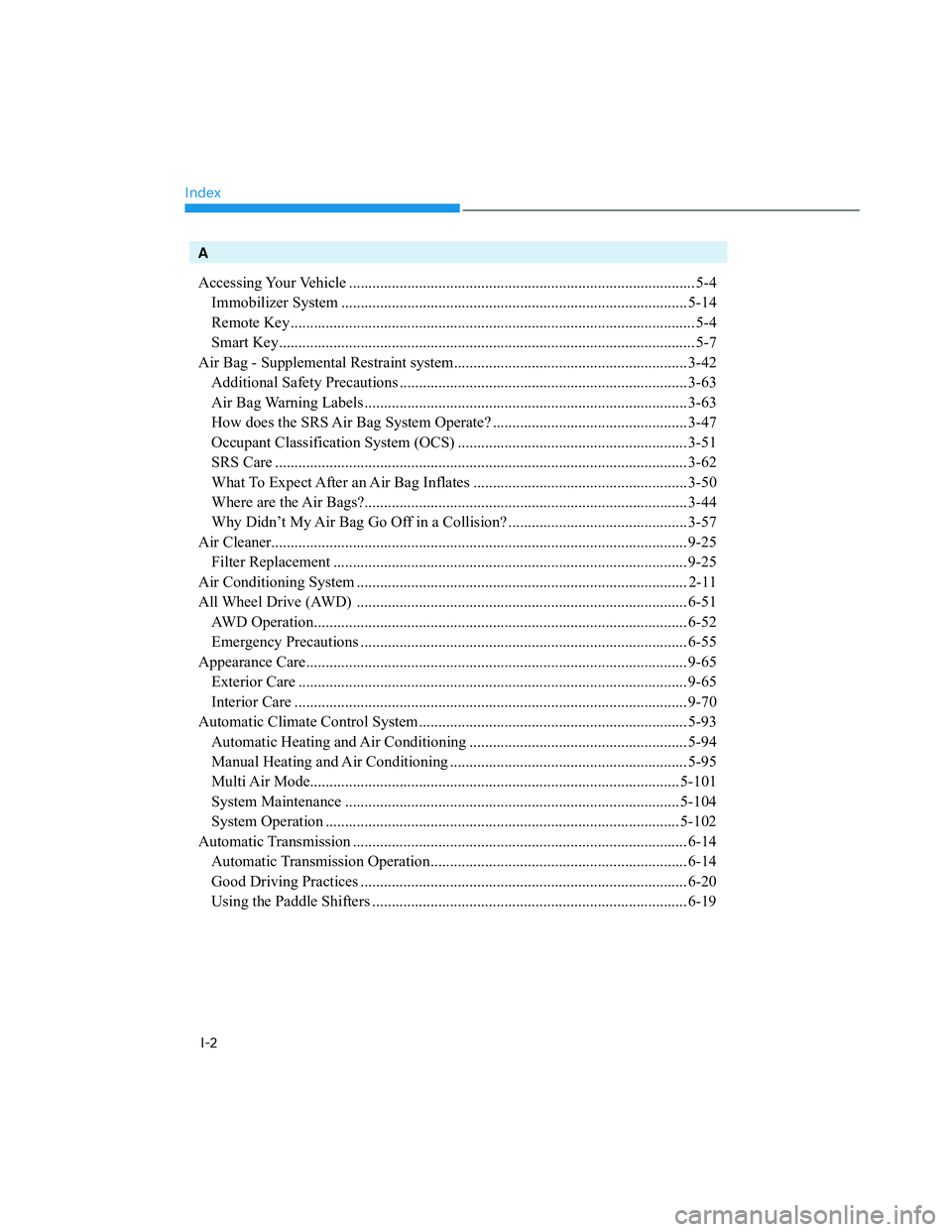
Index
I-2
A
Accessing Your Vehicle ......................................................................................... 5-4
Immobilizer System ......................................................................................... 5-14
Remote Key ........................................................................................................ 5-4
Smart Key........................................................................................................... 5-7
Air Bag - Supplemental Restraint system............................................................ 3-42
Additional Safety Precautions .......................................................................... 3-63
Air Bag Warning Labels ................................................................................... 3-63
How does the SRS Air Bag System Operate? .................................................. 3-47
Occupant Classification System (OCS) ........................................................... 3-51
SRS Care .......................................................................................................... 3-62
What To Expect After an Air Bag Inflates ....................................................... 3-50
Where are the Air Bags?................................................................................... 3-44
Why Didn’t My Air Bag Go Off in a Collision? .............................................. 3-57
Air Cleaner........................................................................................................... 9-25
Filter Replacement ........................................................................................... 9-25
Air Conditioning System ..................................................................................... 2-11
All Wheel Drive (AWD) ..................................................................................... 6-51
AWD Operation................................................................................................ 6-52
Emergency Precautions .................................................................................... 6-55
Appearance Care.................................................................................................. 9-65
Exterior Care .................................................................................................... 9-65
Interior Care ..................................................................................................... 9-70
Automatic Climate Control System..................................................................... 5-93
Automatic Heating and Air Conditioning ........................................................ 5-94
Manual Heating and Air Conditioning ............................................................. 5-95
Multi Air Mode............................................................................................... 5-101
System Maintenance ...................................................................................... 5-104
System Operation ........................................................................................... 5-102
Automatic Transmission ...................................................................................... 6-14
Automatic Transmission Operation.................................................................. 6-14
Good Driving Practices .................................................................................... 6-20
Using the Paddle Shifters ................................................................................. 6-19